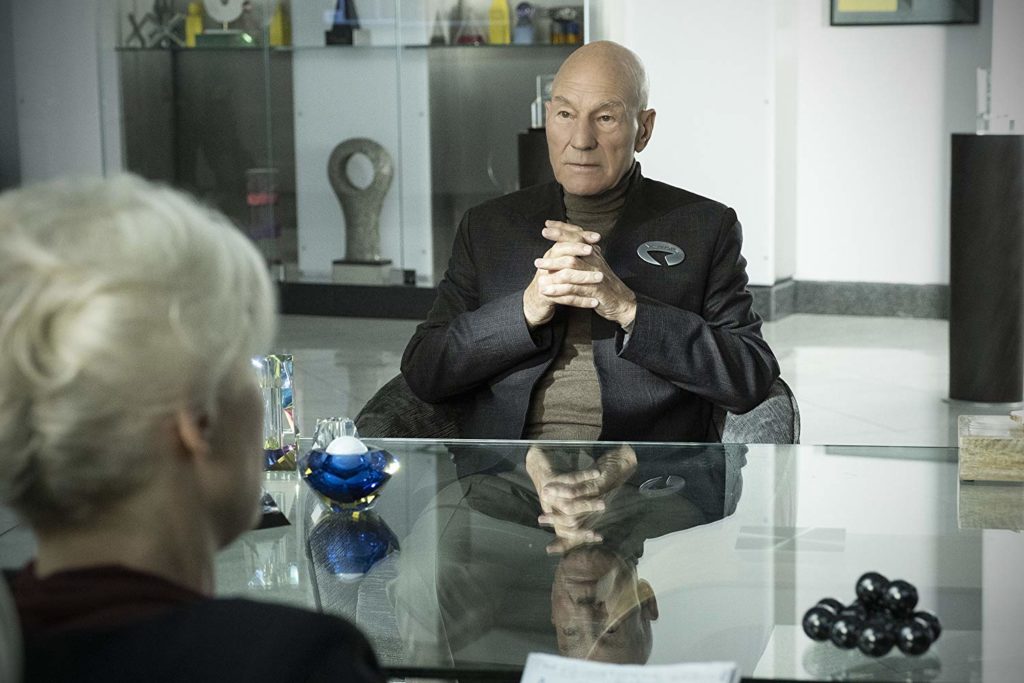
With its second episode, Star Trek: Picard is showing itself to be the modern take on semi-classic Trek we were hoping for, with all the good and the bad that implies.
The good: things are starting to pick up story-wise and intriguing (if occasionally cheesy in that Trek sort of way) characters are being introduced in what is looking like a rather vast conspiracy in the Federation. Picard clearly has no standing in modern Starfleet and his reputation appears to have suffered quite a bit in the last decade or two. We got a great cold open depicting both the status of synthetic beings post-Data (mistreated worker drones of questionable sentience) as well as the horrifying reasons for their outlaw status. As we noted last week, we have no doubt that this darker take on the close of the 24th Century feels very wrong to a lot of classic Trek fans. Either you can make your peace with it or you can’t, but personally, this is exactly the sort of thing we were hoping for.
Having said that, some of these scenes were, as noted, incredibly cheesy in an old-school Trek sort of way – especially when we were subjected to a lot of undercover Romulans standing around and whispering evilly about their plans. Of course this sort of thing isn’t exactly unheard of when you’re talking about Star Trek villains, who generally do have a tendency toward speech-making, and so far, we’re enjoying how well the show is balancing parts of the story that feel classic with parts of it that feel much more forward-looking. We’re starting to love Laris, the Irish-Romulan caregiver, former member of the Tal Shiar, and disliker of cheeky fuckers. Like Alison Pill, Orla Brady has great chemistry with Stewart (although it may be easier to note that Stewart has chemistry with everyone who shares a scene with him). The scene with her and Picard in Dahj’s apartment probably went on too long and got weighed down with too much exposition, but it is fun watching them together.
There’s no denying that the show is moving in a streaming-era fashion. That is to say, at a snail’s pace. But it’s to the show’s credit that it’s not glossing over the fact that an awful lot of time has passed since last we saw this character and his world. And due to the show’s admirable commitment to knitting together various strands of Star Trek lore, many blanks need to be filled in and boxes checked off – not just in Picard’s story, but in mapping out the entire scope and landscape of the Federation and Starfleet in this day and age, post-Nemesis and post-Voyager. At this stage, we’re okay with being patient and we have faith it will pay off. We point again to the credit sequence and how different it is from most other Star Trek credits. Very little of it is set in space and the overall tone is melancholy and elegiac. This is still the story of an old man on the ground looking up to the stars; a very, very different kind of Star Trek story. And a very brave choice on Patrick Stewart’s part.
Also: take note of the costumes. Gone are the broad shouldered metallics and elaborate hairstyles of past Trek shows. In their place? Knitwear, tweeds, and linen – all rendered in naturalistic tones of brown, green and red. For now, the show is relentlessly earthbound by design. At least from Picard’s point of view. When the show switches over to Soji’s story, everything from the art direction to the costumes to the sound design reads alien, futuristic, and outer space. In other words, classic Trek. And what is the entire point of the story so far? Where is it clearly heading? To find Soji. To go from earthbound to the depths of space. We’ll get there.
Yes, we wish things were moving just a bit quicker. We find most of Soji’s scenes with Narek to be interminable, for instance. If there’s one thing almost all Trek shows were bad at depicting in one way or another, it’s sex and romance. We’re desperate for Hugh and Seven of Nine to show their faces, and yes, we wish Picard was out in space by now. But it makes sense that a roughly 90-year-old man with a ruined reputation would need some time to get back where he belongs. And while it’s taking too long to get to some of what we hope will be the good stuff, there are undeniable benefits to the modern, streaming-era version of television plotting (the “every season is a ten-hour movie” model). And it’s a benefit that most Star Trek shows other than Discovery haven’t enjoyed; namely, the time to let plots breathe, unfold and and get more nuanced and complicated than a simple done-in-one episode of classic television would normally allow. We’re not used to a world where Jean-Luc Picard takes his time to assess and solve a problem too complicated to even summarize in one episode. Call us easily pleased if you must; we’re just enjoying the ride too much to complain about the pace.
RED CARPET SHOWDOWN OF THE WEEK: Ariana Grande vs Lizzo Next Post:
Pop Style Opinionfest: The Un-Cancelling of Dolce & Gabbana
Please review our Community Guidelines before posting a comment. Thank you!



